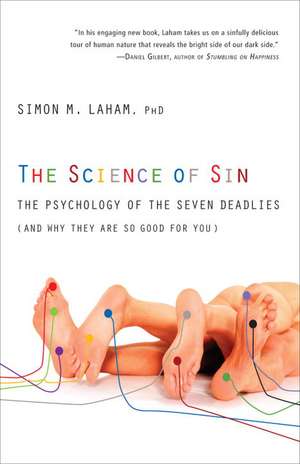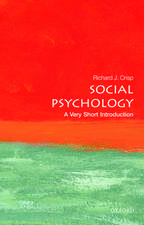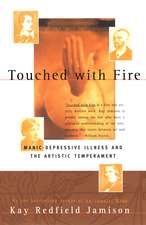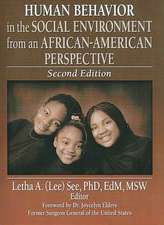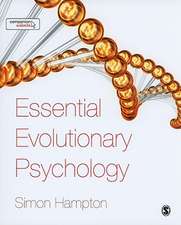The Science of Sin: The Psychology of the Seven Deadlies (and Why They Are So Good for You)
Autor Simon M. Lahamen Limba Engleză Paperback – 31 ian 2012
They’re considered “deadly” because of their capacity to generate other evils. The truth is, we all sin and we do it all the time—in fact, usually several times over before breakfast! But human behavior, argues social psychologist Simon Laham, is more complex than “good” or “evil.” In psychology, these sins aren’t considered morally wrong or even uniformly bad, but are treated rather as complex and interesting psychological states that if, indulged wisely, can be functional, adaptive, and lead to a range of positive effects.
The Science of Sin takes on these so-called sins one by one and through psychological research shows that being bad can be oh-so-good for you. Did you know that:
· Being slow and lazy can help you win the race?
· Anger makes you more open-minded?
· Coveting what others have not only makes you more creative but bolsters self- esteem?
So go ahead, eat that last cookie and kick back on the couch for a day of TV with your neighbor’s boyfriend—from gluttony to greed, envy to lust, Laham shows how even the deadliest, most decadent of vices can make you smart, successful, and happy.
Preț: 104.36 lei
Nou
Puncte Express: 157
Preț estimativ în valută:
19.97€ • 20.77$ • 16.49£
19.97€ • 20.77$ • 16.49£
Carte disponibilă
Livrare economică 24 martie-07 aprilie
Preluare comenzi: 021 569.72.76
Specificații
ISBN-13: 9780307719348
ISBN-10: 0307719340
Pagini: 217
Dimensiuni: 130 x 201 x 18 mm
Greutate: 0.18 kg
Editura: Three Rivers Press (CA)
ISBN-10: 0307719340
Pagini: 217
Dimensiuni: 130 x 201 x 18 mm
Greutate: 0.18 kg
Editura: Three Rivers Press (CA)
Notă biografică
SIMON M. LAHAM, PhD, is a social psychologist whose research focuses on the psychology of morality. He received his PhD at the University of New South Wales, Australia, and is currently a lecturer in psychological science at the University of Melbourne.
Extras
CHAPTER 1
Lust: Bras, Benevolence, and Better Grades
Clothes, rubber, shoes, glasses. This is not a shopping list. These are just some of the myriad and strange objects of lust. Fire and feet, trees and sheep also rate highly on some people's lists of things to do. Not just guys and girls, but animals, vegetables, and minerals of all shapes and sizes are objects of sexual desire. Of course, most of us lust after the regular brand of male or female, with no bells or whistles, no whips or chains or other attachments. But regardless of what turns us on, the consequences of being turned on are much the same.
Whether it's after Fred, Fiona, or Fido, when we lust we think differently and we act differently. And much of this thinking and acting is good for us.
As the sheer variety of lust objects suggests, this sin is a little more complex than you might think at first glance. We psychologists don't really use the term "lust," at least not often, in professional contexts or polite company. Rather, we talk of "activation of the sexual behavioral system." (I won't do this to you, however. So I'll substitute the simple "lust" for this mouthful.) Such activation consists of a complex of physiological reactions, cognitive and emotional responses, and behavioral changes. The main function of the sexual system, as you might expect, is reproduction. This, of course, doesn't mean that we have sex only to reproduce. In fact, according to a recent count, there are exactly 237 reasons why men and women have sex. These include being drunk, wanting to get a promotion, celebrating a special occasion, and wanting to commune with God, as well as the more mundane wanting to feel loved and simply being horny.
Sex can fulfill these sorts of goals, but in evolutionary terms, the sexual system was designed to pass our genes to the next generation. And as you'll see, this system is remarkably well suited for that purpose. When we lust, a cascade of psychological and behavioral shifts is triggered, all aimed at increasing our chances of having sex and, as it turns out, doing much else besides. But before turning our attention to the benefits of lust, let's consider what this sin actually looks like.
What Do We Want?
"Women want love, closeness and someone who'll be a good father to their babies."
"Place a glazed doughnut around your man's member, then gently nibble the pastry and lick the icing . . . as well as his manhood."3
According to men's and women's magazines, the sexes want slightly different things. And although Men's Health and Cosmopolitan might get the details wrong every now and again (personally, I prefer bagels), the sentiment is right: Men and women do lust after different things.
As for the human objects of lust, there are well-documented differences in what turns the sexes on. Heterosexual men typically want youth and beauty and waist-to-hip ratios of about 0.7.4 Heterosexual women, on the other hand, are more often in the market for money, education, and status.5
One of the most interesting things about sex differences in lust is that we actually exploit them when seeking partners. We know what the opposite sex wants, and we play up those very qualities when we're out to impress.
We all do this. Think of the last time you went on a date. Men, did you try to look a little taller, darker, more handsome? And ladies, foundation for clearer skin? Black dress for that slimming effect?
When Jeffrey Hall of the University of Kansas surveyed the data from about five thousand users of online dating services, he found that both men and women were spot-on in their strategic misrepresentations: Men tended to bulk up their personal assets, pandering to women's desire for resources and status, whereas women tended to shave a few pounds off their weight. Both of these strategies make sense given the sexual preferences of the opposite sex.6
Now this might all seem terribly perverse: lying about one's wealth- shocking! But there is a sense in which we may not be able to help it.
James Roney of the University of Chicago induced lust in a group of young male students by exposing them to pictures of young women and then distributed surveys designed to register changes in certain attitudes and preferences. He found that after viewing such pictures, these students valued material wealth much more than when shown pictures of older women.7 These lustful students also placed more value on ambition and status. What seems to be happening here is that lust temporarily rejigs our value systems. When sexually aroused we prefer and exaggerate qualities that increase our chances of sex; this happens without our awareness. These lustful students weren't intentionally valuing ambition and wealth in order to impress; rather, lust subtly penetrated and reconfigured their value systems in order to give them a better chance of attracting mates.
Not only are the particulars of lust between the sexes different, but so too are more general attitudes toward the whole affair. Stereotypes of the indiscriminate man, with a mind to hump anything with a heartbeat, and the more restrained, selective woman both have a kernel of truth. In studies on sexual fantasies, men often report a greater desire for variety than do women.8 The same pattern is seen in men's dreams, with multiple sex partners appearing twice as frequently in men's as in women's dreamtime dalliances.9
The most staggering demonstration that I know of men's indiscriminateness and penchant for variety comes from one of the finest field studies in social psychology.
In 1978 and in 1982, Russell Clark of Florida State University and Elaine Hatfield of the University of Hawaii recruited a group of twenty-two-year-old psychology students to serve as confederates (the term we use to describe experimenters' assistants or stooges) in a study on gender differences in sexual attitudes and behavior.10
Clark and Hatfield's stooges approached strangers of the opposite sex at various places around campus. The confederates were advised to choose only those strangers they found attractive enough that they would actually sleep with them if given the chance. After scanning the crowd and selecting an appropriate sex-worthy candidate, the confederate would approach and say: "I have been noticing you around campus. I find you to be very attractive." After this less-than-smooth icebreaker, the confederate would continue: "Would you like to go out with me tonight?" or "Would you come over to my apartment tonight?" or "Would you go to bed with me tonight?"
In both 1978 and 1982, about 50 percent of participants, male and female, were happy to go on a date with a complete stranger. No gender difference here. But up the stakes a little, and women became somewhat reluctant. Only 6 percent of women were happy to go back to a strange man's apartment in 1978; none was in 1982. And a booty call? Not one woman in the sexually free '70s or early '80s was up for sex with a complete stranger.
The stats couldn't be more different for men. While 50 percent were happy with a date, 69 percent were up for an apartment visit and a healthy 75 percent (69 percent in 1982) were more than willing to head home with a woman for sex. If this last statistic doesn't count as a sex difference, I don't know what does.
Although these differences are striking and robust, there are of course similarities in the structure of lust. Both men and women are attracted to partners who are dependable, mature, kind, healthy, smart, educated, sociable, and interested in home and family.11 And when surveyed about their reasons for having sex, men and women are remarkably similar: Twenty of the top twenty-five reasons given by men and women are identical.12
Sex differences in lust provide an interesting starting point for our exploration of this sin. Next, let's consider the similarities and differences in the effects of lust on the ways men and women think.
Sex on the Brain
As you might imagine, not all studies on lust can be done in the field. Researchers often turn to the laboratory to study sexual arousal and its consequences. And while the occasional experiment involves participants having sexual intercourse in an MRI scanner or having devices with names like "mercury-in-rubber strain gauge" or "vaginal photoplethysmograph" hooked up to various parts of their genitalia, most social psychologists are happy to resort to good old- fashioned priming techniques.13 More on priming next.) Typically, researchers show their lucky participants pictures of naked men and women, or words like penis and orgasm, and then wait to see what happens.
Take a study by Omri Gillath of the University of Kansas and his colleagues.14 In this study participants completed what we call a lexical decision task, or LDT, which is used to measure the activation of concepts in the mind.
Here's how it works.
On each trial of an LDT, a string of letters flashes up on a computer screen and participants have to make a judgment about whether the letter string is a word or a nonword (i.e., they have to make a lexical decision). So on one trial you might see "hretea," to which you would hopefully respond "nonword" by pushing the appropriate button. On another trial, you might see "table," to which you would respond by pushing the "word" button. Of interest to researchers are reaction times to "word" responses-how long does it take you to deem "table" a word? The quicker the reaction time, the greater the activation of concepts related to the target word.
Things get particularly interesting in the LDT when "primes" are inserted between trials. Say, for example, that the word "chair" is flashed on screen briefly before "table." You're told to ignore the first word ("chair," called the prime) and respond with a lexical decision to the second letter string ("table," called the target). What happens here is that reaction times for judging "table" to be a word tend to be shorter after a "chair" prime than after a nonword prime (e.g., "ghjsj"). Why? It's about spreading activation in the associative networks that comprise our minds. The mind is a huge network of interconnected ideas and concepts. And when one concept in the network is activated (e.g., via presentation of the word "chair" in the LDT), this activation spreads to other, related concepts (e.g., "table") and thereby primes these concepts, making it easier to use them when needed.
Gillath, of course, wasn't interested in chairs and tables. He was more concerned with sex. But he used the same logic. Instead of words like "table," Gillath examined how long it took people to respond to target words such as "penis," "orgasm," and "intercourse." And instead of word primes, he used pictures of naked people of the opposite sex to the participant. What he found was that subjects were indeed faster to judge "penis," "intercourse," and other sex-related targets as words after being exposed to naked picture primes. (Even more fascinating is the fact that the primes used here were subliminal. They were presented for only thirty milliseconds, a time too short for participants to consciously register the content of the prime.) So exposure to sex cues triggers a spread of sex-concept activation across the associative networks of our minds, quite literally putting sex on the brain. But to what end?
What Gillath's study suggests is that thinking about sex (even nonconsciously) lowers our thresholds for perceiving sex-related information in the environment. In short, we start to see more and more cues as sexual. The most obvious advantage of this cognitive shift is that it increases our chances of having sex. Our basic cognitive functions become attuned to all things sexual, and this makes it more likely that we'll score.
The power of this mental shift becomes clearer when we consider some work by Jon Maner of Florida State University. In a fascinating series of studies, Maner primed undergraduate students with a "mating goal" (which is just a fancy way of saying he got students to think about sex).15 He did this by showing a film clip in which an attractive man and woman get together and go on a romantic first date. After this he showed subjects photos of people of varying attractiveness. What he was interested in was participants' ratings of these photos for apparent expressions of sexual arousal. If lust is doing its job and gearing up the individual for sex, then we would expect that lust-primed participants would see sexual arousal in others, viewing others as potential mates. And this is basically what Maner found. Those who had sex on the brain after watching the romantic film read more sexual intent in the faces of others than did those in a control condition, who watched a thoroughly nonsexual documentary about people going up and down escalators. (The effect, however, was restricted to male participants who saw physically attractive targets.)
So on the whole, lust seems to be doing its job. It puts sex on the brain, which leads us to see sex in the environment, which, in turn, gives us the impression that the odds of having sex look pretty good. Other lust-induced cognitive shifts: we find other people more attractive when we're aroused and we pay more attention to physically attractive (i.e., sex-worthy) others.16 In psych-speak: activated mating goals (triggered by exposure to naked pictures and the like) induce cognitive and behavioral strategies aimed at facilitating our reproductive success. In non-psych-speak: thinking about sex makes us think more about sex, which increases behaviors aimed at getting sex.
Sex and Trees
(Some people are sexually attracted to trees. This is called dendrophilia. This is not what this section is about.)
Lust is clearly good at triggering thinking and behavior that increase our chances of sex. But lust's implications for thought and action are far more -wide--ranging.
One thing this sin does is focus attention on the immediate present. This of course makes sense given that lust is directed at a pressing current goal, namely, sex. It pays to focus our attention on stimuli in the immediate environment (usually people; sometimes clothes or rubber, or, yes, trees) that will fulfill the activated sex goal.
But this "present" focus that lust inspires is emblematic of a more generalized cognitive shift. Lust prompts us to place a premium not only on sexual stimuli in the present, but on other rewards as well.
Readers, I want you to do your best to get your hands on a bra. Go to your underwear drawer or to your partner's or use whatever other means are necessary. Now look at the bra. Feel the fabric. What do you think of the embroidery? The general craftsmanship?
Now, I want you to think about this choice:
I can give you $15 right now or some other amount in one week. How much money would I have to give you in one week's time in order to dissuade you from accepting $15 right now?
Lust: Bras, Benevolence, and Better Grades
Clothes, rubber, shoes, glasses. This is not a shopping list. These are just some of the myriad and strange objects of lust. Fire and feet, trees and sheep also rate highly on some people's lists of things to do. Not just guys and girls, but animals, vegetables, and minerals of all shapes and sizes are objects of sexual desire. Of course, most of us lust after the regular brand of male or female, with no bells or whistles, no whips or chains or other attachments. But regardless of what turns us on, the consequences of being turned on are much the same.
Whether it's after Fred, Fiona, or Fido, when we lust we think differently and we act differently. And much of this thinking and acting is good for us.
As the sheer variety of lust objects suggests, this sin is a little more complex than you might think at first glance. We psychologists don't really use the term "lust," at least not often, in professional contexts or polite company. Rather, we talk of "activation of the sexual behavioral system." (I won't do this to you, however. So I'll substitute the simple "lust" for this mouthful.) Such activation consists of a complex of physiological reactions, cognitive and emotional responses, and behavioral changes. The main function of the sexual system, as you might expect, is reproduction. This, of course, doesn't mean that we have sex only to reproduce. In fact, according to a recent count, there are exactly 237 reasons why men and women have sex. These include being drunk, wanting to get a promotion, celebrating a special occasion, and wanting to commune with God, as well as the more mundane wanting to feel loved and simply being horny.
Sex can fulfill these sorts of goals, but in evolutionary terms, the sexual system was designed to pass our genes to the next generation. And as you'll see, this system is remarkably well suited for that purpose. When we lust, a cascade of psychological and behavioral shifts is triggered, all aimed at increasing our chances of having sex and, as it turns out, doing much else besides. But before turning our attention to the benefits of lust, let's consider what this sin actually looks like.
What Do We Want?
"Women want love, closeness and someone who'll be a good father to their babies."
"Place a glazed doughnut around your man's member, then gently nibble the pastry and lick the icing . . . as well as his manhood."3
According to men's and women's magazines, the sexes want slightly different things. And although Men's Health and Cosmopolitan might get the details wrong every now and again (personally, I prefer bagels), the sentiment is right: Men and women do lust after different things.
As for the human objects of lust, there are well-documented differences in what turns the sexes on. Heterosexual men typically want youth and beauty and waist-to-hip ratios of about 0.7.4 Heterosexual women, on the other hand, are more often in the market for money, education, and status.5
One of the most interesting things about sex differences in lust is that we actually exploit them when seeking partners. We know what the opposite sex wants, and we play up those very qualities when we're out to impress.
We all do this. Think of the last time you went on a date. Men, did you try to look a little taller, darker, more handsome? And ladies, foundation for clearer skin? Black dress for that slimming effect?
When Jeffrey Hall of the University of Kansas surveyed the data from about five thousand users of online dating services, he found that both men and women were spot-on in their strategic misrepresentations: Men tended to bulk up their personal assets, pandering to women's desire for resources and status, whereas women tended to shave a few pounds off their weight. Both of these strategies make sense given the sexual preferences of the opposite sex.6
Now this might all seem terribly perverse: lying about one's wealth- shocking! But there is a sense in which we may not be able to help it.
James Roney of the University of Chicago induced lust in a group of young male students by exposing them to pictures of young women and then distributed surveys designed to register changes in certain attitudes and preferences. He found that after viewing such pictures, these students valued material wealth much more than when shown pictures of older women.7 These lustful students also placed more value on ambition and status. What seems to be happening here is that lust temporarily rejigs our value systems. When sexually aroused we prefer and exaggerate qualities that increase our chances of sex; this happens without our awareness. These lustful students weren't intentionally valuing ambition and wealth in order to impress; rather, lust subtly penetrated and reconfigured their value systems in order to give them a better chance of attracting mates.
Not only are the particulars of lust between the sexes different, but so too are more general attitudes toward the whole affair. Stereotypes of the indiscriminate man, with a mind to hump anything with a heartbeat, and the more restrained, selective woman both have a kernel of truth. In studies on sexual fantasies, men often report a greater desire for variety than do women.8 The same pattern is seen in men's dreams, with multiple sex partners appearing twice as frequently in men's as in women's dreamtime dalliances.9
The most staggering demonstration that I know of men's indiscriminateness and penchant for variety comes from one of the finest field studies in social psychology.
In 1978 and in 1982, Russell Clark of Florida State University and Elaine Hatfield of the University of Hawaii recruited a group of twenty-two-year-old psychology students to serve as confederates (the term we use to describe experimenters' assistants or stooges) in a study on gender differences in sexual attitudes and behavior.10
Clark and Hatfield's stooges approached strangers of the opposite sex at various places around campus. The confederates were advised to choose only those strangers they found attractive enough that they would actually sleep with them if given the chance. After scanning the crowd and selecting an appropriate sex-worthy candidate, the confederate would approach and say: "I have been noticing you around campus. I find you to be very attractive." After this less-than-smooth icebreaker, the confederate would continue: "Would you like to go out with me tonight?" or "Would you come over to my apartment tonight?" or "Would you go to bed with me tonight?"
In both 1978 and 1982, about 50 percent of participants, male and female, were happy to go on a date with a complete stranger. No gender difference here. But up the stakes a little, and women became somewhat reluctant. Only 6 percent of women were happy to go back to a strange man's apartment in 1978; none was in 1982. And a booty call? Not one woman in the sexually free '70s or early '80s was up for sex with a complete stranger.
The stats couldn't be more different for men. While 50 percent were happy with a date, 69 percent were up for an apartment visit and a healthy 75 percent (69 percent in 1982) were more than willing to head home with a woman for sex. If this last statistic doesn't count as a sex difference, I don't know what does.
Although these differences are striking and robust, there are of course similarities in the structure of lust. Both men and women are attracted to partners who are dependable, mature, kind, healthy, smart, educated, sociable, and interested in home and family.11 And when surveyed about their reasons for having sex, men and women are remarkably similar: Twenty of the top twenty-five reasons given by men and women are identical.12
Sex differences in lust provide an interesting starting point for our exploration of this sin. Next, let's consider the similarities and differences in the effects of lust on the ways men and women think.
Sex on the Brain
As you might imagine, not all studies on lust can be done in the field. Researchers often turn to the laboratory to study sexual arousal and its consequences. And while the occasional experiment involves participants having sexual intercourse in an MRI scanner or having devices with names like "mercury-in-rubber strain gauge" or "vaginal photoplethysmograph" hooked up to various parts of their genitalia, most social psychologists are happy to resort to good old- fashioned priming techniques.13 More on priming next.) Typically, researchers show their lucky participants pictures of naked men and women, or words like penis and orgasm, and then wait to see what happens.
Take a study by Omri Gillath of the University of Kansas and his colleagues.14 In this study participants completed what we call a lexical decision task, or LDT, which is used to measure the activation of concepts in the mind.
Here's how it works.
On each trial of an LDT, a string of letters flashes up on a computer screen and participants have to make a judgment about whether the letter string is a word or a nonword (i.e., they have to make a lexical decision). So on one trial you might see "hretea," to which you would hopefully respond "nonword" by pushing the appropriate button. On another trial, you might see "table," to which you would respond by pushing the "word" button. Of interest to researchers are reaction times to "word" responses-how long does it take you to deem "table" a word? The quicker the reaction time, the greater the activation of concepts related to the target word.
Things get particularly interesting in the LDT when "primes" are inserted between trials. Say, for example, that the word "chair" is flashed on screen briefly before "table." You're told to ignore the first word ("chair," called the prime) and respond with a lexical decision to the second letter string ("table," called the target). What happens here is that reaction times for judging "table" to be a word tend to be shorter after a "chair" prime than after a nonword prime (e.g., "ghjsj"). Why? It's about spreading activation in the associative networks that comprise our minds. The mind is a huge network of interconnected ideas and concepts. And when one concept in the network is activated (e.g., via presentation of the word "chair" in the LDT), this activation spreads to other, related concepts (e.g., "table") and thereby primes these concepts, making it easier to use them when needed.
Gillath, of course, wasn't interested in chairs and tables. He was more concerned with sex. But he used the same logic. Instead of words like "table," Gillath examined how long it took people to respond to target words such as "penis," "orgasm," and "intercourse." And instead of word primes, he used pictures of naked people of the opposite sex to the participant. What he found was that subjects were indeed faster to judge "penis," "intercourse," and other sex-related targets as words after being exposed to naked picture primes. (Even more fascinating is the fact that the primes used here were subliminal. They were presented for only thirty milliseconds, a time too short for participants to consciously register the content of the prime.) So exposure to sex cues triggers a spread of sex-concept activation across the associative networks of our minds, quite literally putting sex on the brain. But to what end?
What Gillath's study suggests is that thinking about sex (even nonconsciously) lowers our thresholds for perceiving sex-related information in the environment. In short, we start to see more and more cues as sexual. The most obvious advantage of this cognitive shift is that it increases our chances of having sex. Our basic cognitive functions become attuned to all things sexual, and this makes it more likely that we'll score.
The power of this mental shift becomes clearer when we consider some work by Jon Maner of Florida State University. In a fascinating series of studies, Maner primed undergraduate students with a "mating goal" (which is just a fancy way of saying he got students to think about sex).15 He did this by showing a film clip in which an attractive man and woman get together and go on a romantic first date. After this he showed subjects photos of people of varying attractiveness. What he was interested in was participants' ratings of these photos for apparent expressions of sexual arousal. If lust is doing its job and gearing up the individual for sex, then we would expect that lust-primed participants would see sexual arousal in others, viewing others as potential mates. And this is basically what Maner found. Those who had sex on the brain after watching the romantic film read more sexual intent in the faces of others than did those in a control condition, who watched a thoroughly nonsexual documentary about people going up and down escalators. (The effect, however, was restricted to male participants who saw physically attractive targets.)
So on the whole, lust seems to be doing its job. It puts sex on the brain, which leads us to see sex in the environment, which, in turn, gives us the impression that the odds of having sex look pretty good. Other lust-induced cognitive shifts: we find other people more attractive when we're aroused and we pay more attention to physically attractive (i.e., sex-worthy) others.16 In psych-speak: activated mating goals (triggered by exposure to naked pictures and the like) induce cognitive and behavioral strategies aimed at facilitating our reproductive success. In non-psych-speak: thinking about sex makes us think more about sex, which increases behaviors aimed at getting sex.
Sex and Trees
(Some people are sexually attracted to trees. This is called dendrophilia. This is not what this section is about.)
Lust is clearly good at triggering thinking and behavior that increase our chances of sex. But lust's implications for thought and action are far more -wide--ranging.
One thing this sin does is focus attention on the immediate present. This of course makes sense given that lust is directed at a pressing current goal, namely, sex. It pays to focus our attention on stimuli in the immediate environment (usually people; sometimes clothes or rubber, or, yes, trees) that will fulfill the activated sex goal.
But this "present" focus that lust inspires is emblematic of a more generalized cognitive shift. Lust prompts us to place a premium not only on sexual stimuli in the present, but on other rewards as well.
Readers, I want you to do your best to get your hands on a bra. Go to your underwear drawer or to your partner's or use whatever other means are necessary. Now look at the bra. Feel the fabric. What do you think of the embroidery? The general craftsmanship?
Now, I want you to think about this choice:
I can give you $15 right now or some other amount in one week. How much money would I have to give you in one week's time in order to dissuade you from accepting $15 right now?
Recenzii
“In his engaging new book, Laham takes us on a sinfully delicious tour of human nature that reveals the bright side of our dark side.”
ߝ Daniel Gilbert, author of Stumbling on Happiness
“A lighthearted foray into motivational research.”
- Kirkus Reviews
ߝ Daniel Gilbert, author of Stumbling on Happiness
“A lighthearted foray into motivational research.”
- Kirkus Reviews
Descriere
"The Science of Sin" is a simultaneously fun and serious work of pop science in which an award-winning social psychologist uses modern research and historical anecdotes to make a case for living a sinful life.
